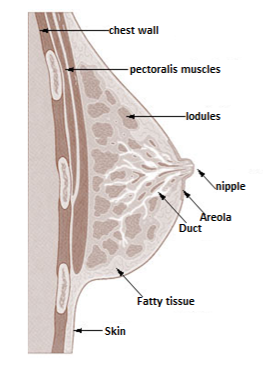
Mammary glands are modified
A. Cutaneous glands
B. Sebaceous glands
C. Sweat glands
D. Scent glands
Answer
558k+ views
Hint:Presence of mammary glands is the peculiar character of mammals. In mammals, mammary glands are well developed in females and underdeveloped in males. Female gives nutrition to the newborn baby through the mammary glands.
Complete answer:
Sweat glands and Sebaceous glands are a type of simple glands. Sweat glands are simple coiled tubular glands in which the terminal part is coiled. While sebaceous glands are branched alveolar glands.
In prototherian mammals, mammary glands are compound tubular and in Eutherian mammals, mammary glands are compound tubular alveolar or tubule saccular. Such glands are tubular as well as alveolar type.
The structurally mammary gland consists of lobes and these lobes are called mammary lobes. These lobes are surrounded by adipose tissue. The hormone estrogen is responsible for the deposition of fat around the mammary lobe.

Inside mammary lobes, mammary alveoli are present. The function of mammary alveoli is the synthesis of milk. Prolactin hormone promotes milk synthesis and the development of mammary alveoli is under the influence of progesterone hormone. These alveoli are connected with mammary ducts and these ducts open into a broader part i.e. mammary ampulla. The mammary ampulla is a site where temporary storage of milk occurs.
Mammary ampulla connected with the nipple by the lactiferous ducts. Oxytocin is a milk releasing hormone released by the posterior pituitary.
By considering the above structure of the mammary gland it is a modified tubular gland.
Hence the answer to the given question is option C) Sweat glands
Note: Based on secretion mammary glands are apocrine glands. In such a type of gland apical portion of the cell is degenerated along with the secretions from the cell. That degenerated part can regenerate again.
Complete answer:
Sweat glands and Sebaceous glands are a type of simple glands. Sweat glands are simple coiled tubular glands in which the terminal part is coiled. While sebaceous glands are branched alveolar glands.
In prototherian mammals, mammary glands are compound tubular and in Eutherian mammals, mammary glands are compound tubular alveolar or tubule saccular. Such glands are tubular as well as alveolar type.
The structurally mammary gland consists of lobes and these lobes are called mammary lobes. These lobes are surrounded by adipose tissue. The hormone estrogen is responsible for the deposition of fat around the mammary lobe.

Inside mammary lobes, mammary alveoli are present. The function of mammary alveoli is the synthesis of milk. Prolactin hormone promotes milk synthesis and the development of mammary alveoli is under the influence of progesterone hormone. These alveoli are connected with mammary ducts and these ducts open into a broader part i.e. mammary ampulla. The mammary ampulla is a site where temporary storage of milk occurs.
Mammary ampulla connected with the nipple by the lactiferous ducts. Oxytocin is a milk releasing hormone released by the posterior pituitary.
By considering the above structure of the mammary gland it is a modified tubular gland.
Hence the answer to the given question is option C) Sweat glands
Note: Based on secretion mammary glands are apocrine glands. In such a type of gland apical portion of the cell is degenerated along with the secretions from the cell. That degenerated part can regenerate again.
Recently Updated Pages
Why are manures considered better than fertilizers class 11 biology CBSE

Find the coordinates of the midpoint of the line segment class 11 maths CBSE

Distinguish between static friction limiting friction class 11 physics CBSE

The Chairman of the constituent Assembly was A Jawaharlal class 11 social science CBSE

The first National Commission on Labour NCL submitted class 11 social science CBSE

Number of all subshell of n + l 7 is A 4 B 5 C 6 D class 11 chemistry CBSE

Trending doubts
Differentiate between an exothermic and an endothermic class 11 chemistry CBSE

10 examples of friction in our daily life

One Metric ton is equal to kg A 10000 B 1000 C 100 class 11 physics CBSE

Difference Between Prokaryotic Cells and Eukaryotic Cells

State the laws of reflection of light

Explain zero factorial class 11 maths CBSE




